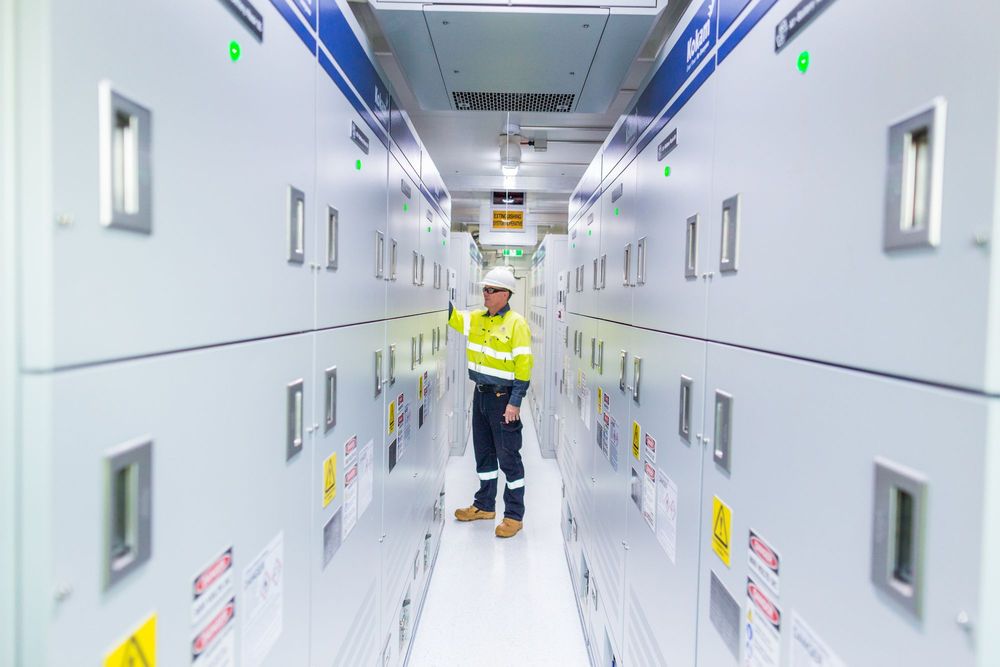The 100 MW two-hour battery energy storage system will be built adjacent to Alinta Energy’s 380 MW gas and diesel-fired power plant at Wagerup, about 120 kilometres south of Perth in Western Australia’s southwest.
Alinta said the utility scale battery will create the opportunity for more renewable generation to be connected to the state’s main grid, known as the South-West Interconnected System (SWIS), while maintaining power quality and continuity of supply.
“With the continued introduction of intermittent energy sources into the SWIS, such as domestic and utility scale solar, the need for fast-start, balancing capacity becomes more important,” the Chinese-owned company said in its application papers.
“The ability of large batteries to respond instantly to fluctuations on the grid is critical to the development and operation of increased renewable energy in the state.”
Alinta Energy Chief Development Officer Ken Woolley said the battery will connect to existing high-voltage infrastructure at the Wagerup power station and is scheduled to be commissioned during the “second half of 2024.”
“We’re excited about the contribution the Wagerup battery will make to stabilising the southwest WA grid, and providing back-up capacity when needed,” he said.
Work on the estimated $100 million (USD 64 million) project is to commence immediately with electrical design firm Shanghai Electric Power Design Institute (SEPD) and Australian solar and battery installer Sunterra appointed to deliver the battery.
Alinta’s announcement coincided with the release of a report from the Australian Energy Market Operator (AEMO) that flags the need for “significant and sustained investment in generation, storage and transmission to meet reliability standards in the SWIS.”
In its latest Wholesale Energy Market (WEM) Electricity Statement of Opportunity, AEMO predicts an increase in electricity use and peak demand levels in WA driven by electrification, electric vehicle (EV) uptake, and new energy-intensive industries including green hydrogen production.
The report, which takes into account 1,348 MW of generation from ‘probable’ new projects, suggests the state will have a shortfall of 945 MW by 2025-26. This is expected to increase to about 4 GW by 2032-33, a significant shift compared to the 2022 WEM ESOO outlook, where the additional capacity requirement was expected to reach 303 MW by 2031-32.
AEMO Executive General Manager Western Australia and Strategy, Kate Ryan, said “this year’s reliability outlook highlights the need for significant and sustained investment in additional capacity, fast-tracking the pipeline of generation, storage and demand-side projects, along with investment in transmission infrastructure, to meet reliability standards.
“The rapid energy transition is now fuelling very strong forecast growth in electricity demand,” she said. “At the same time, we’re transitioning to new, lower-emissions sources of supply and managing the phase out of coal-fired generation.”
“Increased capacity investment is needed for a robust and resilient power system capable of meeting future demand and facilitating the transition to a cleaner and more sustainable energy future.”
The release of the report prompted the state government to push back the retirement of the Muja coal-fired power station in Collie to ensure wider energy system security during the high demand period of the hot summer months.
Synergy’s Muja 6 plant was due to close in October 2024, but that will now be delayed until April 2025. The unit will be placed on reserve outage mode during that period to be available for significant peak demand events.
The state government said the delay will not impact the planned retirement of the state’s remaining coal-fired units by 2030, with Collie and Muja Power Stations scheduled to close in 2027 and 2029 respectively.
This content is protected by copyright and may not be reused. If you want to cooperate with us and would like to reuse some of our content, please contact: editors@pv-magazine.com.









1 comment
By submitting this form you agree to pv magazine using your data for the purposes of publishing your comment.
Your personal data will only be disclosed or otherwise transmitted to third parties for the purposes of spam filtering or if this is necessary for technical maintenance of the website. Any other transfer to third parties will not take place unless this is justified on the basis of applicable data protection regulations or if pv magazine is legally obliged to do so.
You may revoke this consent at any time with effect for the future, in which case your personal data will be deleted immediately. Otherwise, your data will be deleted if pv magazine has processed your request or the purpose of data storage is fulfilled.
Further information on data privacy can be found in our Data Protection Policy.